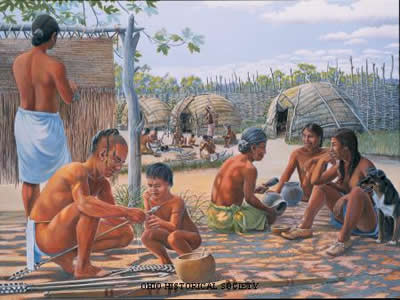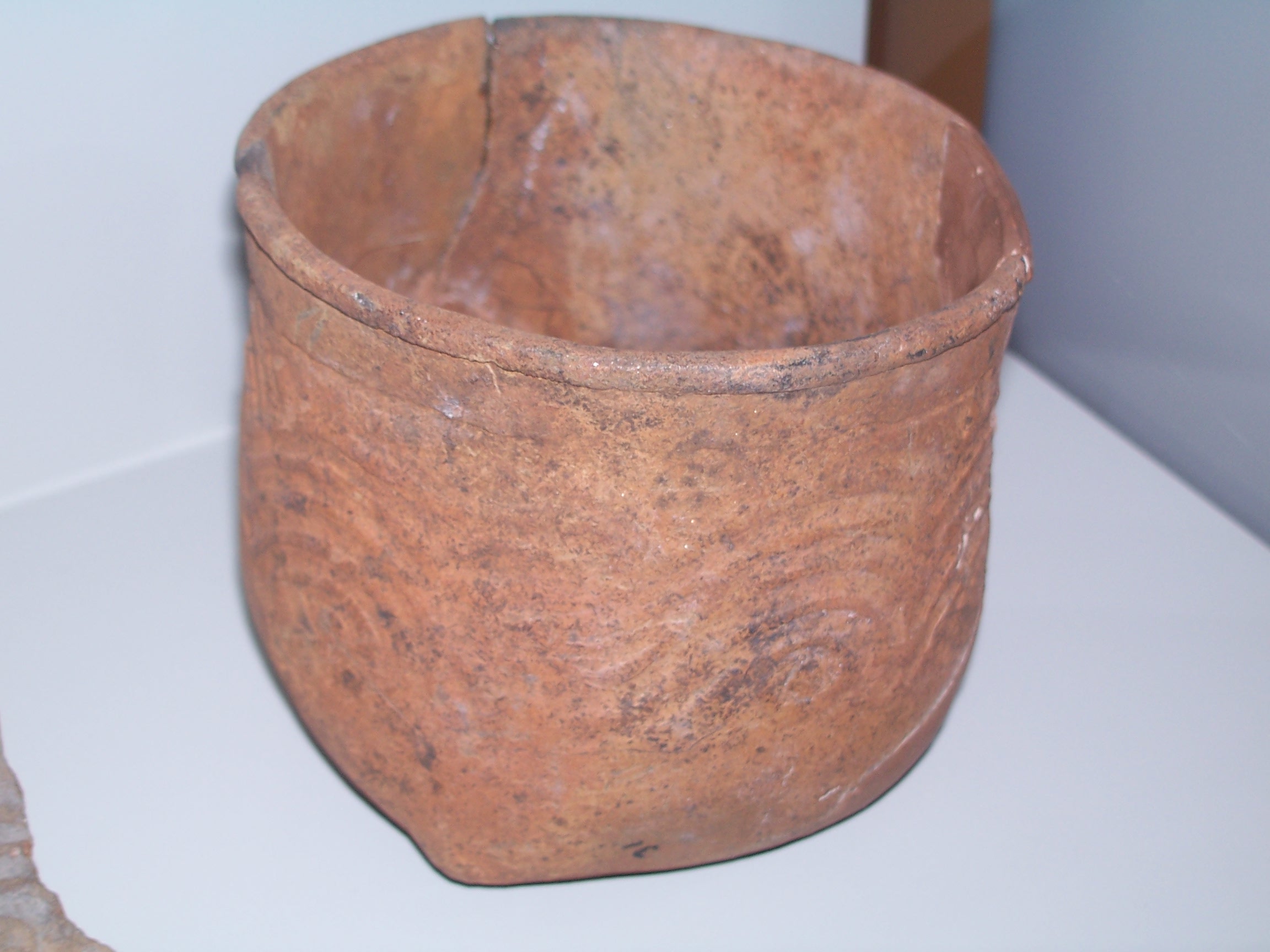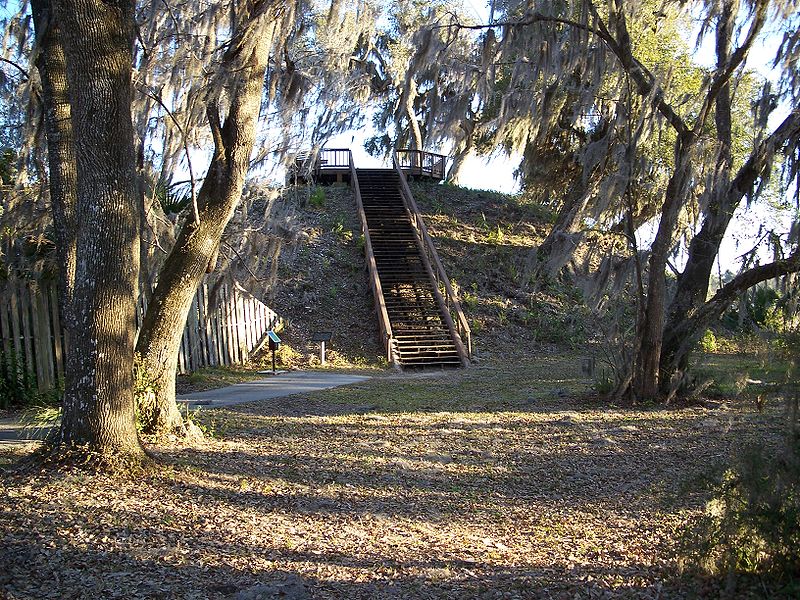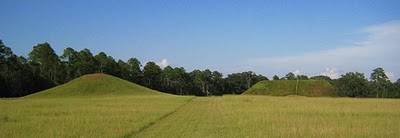
Around A.D. 500, the archeological record reveals a sharp decline in the construction of Middle Woodland burial mounds in the Hopewellian core area of the Ohio River drainage. The decline in the construction of burial mounds is accompanied by disruption of the long-distance trade in exotic materials and interregional art styles.
Traditionally, archeologists have viewed the Late Woodland (ca. A.D. 500 – 1000) as a time of cultural poverty. Late Woodland settlements, with the exception of sites along the Florida Gulf Coast, tended to be small when compared with Middle Woodland sites. Based on our present-day perspective, few outstanding works of prehistoric art or architecture can be attributed to this time period. Careful analysis, however, shows that, throughout the Southeast, the Late Woodland was a very dynamic period. Bow-and-arrow technology, allowing for increased hunting efficiency, became widespread. New varieties of maize, beans, and squash were introduced or gained economic importance at this time, which greatly supplemented existing native seed and root plants. Finally, although settlement size was small, there was a marked increase in the numbers of Late Woodland sites over Middle Woodland sites, indicating a population increase. These factors tend to give a view of the Late Woodland period as an expansive period, not one of a cultural collapse.
Woodland Triangular points, sometimes referred to as Hamilton points were used almost exclusively throughout Georgia during the Late Archaic Period. These were the first true “arrow heads.”
The reasons for possible cultural degradations at the end of the Middle Woodland and the subsequent emergence of the Late Woodland are poorly understood. There are several possible explanations. The first is that populations increased beyond the point of carrying capacity of the land, and, as the trade system broke down, clans resorted to raiding rather than trading with other territories to acquire important resources. A second possibility is that a rapid replacement of the Late Archaic spear and atlatl with the newer bow-and-arrow technology quickly decimated the large game animals, interrupting the hunting component of food procurement and resulting in settlements breaking down into smaller units to subsist on local resources. This ended long distance trade and the need for elite social units. A third possible reason is that colder climate conditions about A.D. 400 might have affected yields of gathered foods, such as nuts or starchy seeds, thereby disrupting the trade networks.
A fourth and possibly interrelated reason is that intensified horticulture became so successful that increased agricultural production may have reduced variation in food resource availability between differing areas. This reliance on horticulture, involving only a few types of plants, would have carried with it a risk where variations in rainfall or climate could cause famine or shortages.
Rather than a prehistoric interaction sphere sharing earthen architecture memorialization of the dead and the exchange of high status goods of nonlocal materials, as existed in the Middle Woodland, the Late Woodland saw the rise of numerous small-scale cultures distinctive to particular geographical areas.
In the Carolinas, the Late Woodland (A.D. 600-1100) was a continuation of the Middle Woodland Deptford culture. Even sand burial mounds continued to be constructed. The Late Woodland period for this area is differentiated from the early Middle Woodland on the basis of the tempering and surface treatment of pottery styles.
The Late Woodland cultures in coastal North Carolina, such as the Colington (historic Carolina Algonkian) and Cashie (historic Carolina Tuscarora) phases, emerged about A.D. 800. These cultures continued essentially unchanged until ca. A.D. 1520, when contact with Europeans in the Carolinas occurred. Shell and grit-tempered pottery, horticulture (involving maize, squash, sunflowers, and beans), burial ossuaries, bow-and-arrow technology, palisaded villages, and seasonal settlement movement to supplement horticulture with hunting and gathering, typify these cultures. These cultures are present at Fort Raleigh National Historic Site and possibly Cape Hatteras National Seashore.
The Late Woodland of the piedmont and western North Carolina (A.D. 600 – 1000) is presently not as well understood as either the previous Middle Woodland or the South Appalachian Mississippian culture that succeeded it. Likewise, the information on Late Woodland for much of South Carolina is so scant that some researchers have postulated a depopulation of the area for much of this period until replacement by the South Appalachian Mississippian culture.

In Georgia, Alabama, east Tennessee, and northern Florida, Late Woodland sites are identified by the occurrence of Swift Creek pottery styles through ca. A.D. 750. Gradually, this area evolved into the core area of the South Appalachian Mississippian culture by about A.D. 1000.
In northeast Florida, the St. Johns culture, discussed above in the Middle Woodland period, continued as the Timucuan culture up to contact with Europeans in the sixteenth century with few modifications in their material culture and subsistence base. Timucuan sites have been recognized in such parks as Timucuan Ecological And Historic Preserve, Fort Matanzas National Monument, Cumberland Island National Seashore, and Canaveral National Seashore. Similarly, the Calloosahatchee Region of southwest Florida, (ca. A.D. 700) saw the beginning of the Calusa culture at present-day Big Cypress National Preserve and Everglades National Park. This cultural group subsisted to a large extent on maritime food resources, yet constructed large settlements and temple mounds. The Calusa culture continued as the dominant culture in south Florida through the sixteenth century.
The Weeden Island culture (A.D. 300-1000) developed locally in northwest Florida, probably out of the preceding Swift Creek culture, and spread throughout much of northern Florida and the panhandle of the Gulf Coast including areas now contained in Gulf Islands National Seashore. Weeden Island culture was characterized by the construction of burial mounds containing nonlocal burial goods, interred with the dead in imitation of Middle Woodland cultures. The subsistence strategies of the Weeden Island cultures were initially concerned with the seasonal collecting of wild plant foods and shellfish. However, by A.D. 800 in the interior coastal plain, maize horticulture appears to account for a good portion of the food supply, allowing for expansion of the territory and elaboration of political power.

The Crystal River Mounds, located along the central Gulf Coast of Florida, were used from early Middle Woodland times through the Late Woodland period.

The Kolomoki Mounds were used during the Middle and Late Woodland periods. The dominant ceramic types include Swift Creek Complicated and Weeden Island types.
As a display of this power, the Weeden Island culture undertook the construction of some of the earliest dated flat-topped platform (or temple) mounds (ca. A.D. 400). Apparently, these early mounds were intended to serve as bases for charnel houses for the dead as opposed to merely interment mounds for the elite of the Weeden Island culture. Eventually, evidence appears of multiple flat-topped mounds serving as a mortuary complex, with some mounds also serving as the base for a structure for the head of a clan or lineage. In this respect, the Weeden Island flat-topped temple or charnel house mounds may be considered proto-Mississippian models for more complex societies in the Southeast after ca. A.D. 1000. Influenced by the Weeden Island culture, cultures in Georgia, Tennessee, Alabama, and Mississippi also constructed flat-topped mounds during the Late Woodland period.
The lower Mississippi River Valley, consisting of eastern Arkansas, western Tennessee, Louisiana, and western Mississippi, saw the emergence of the Late Woodland Baytown culture (A.D. 300-700). The Baytown culture succeeded the Marksville culture of the Middle Woodland. Instead of major earthwork centers, the Baytown culture built dispersed settlements. Major innovations in the Baytown phase were the introduction of bow-and-arrow technology and horticulture.
In other areas of Louisiana and Arkansas arose the Late Woodland Troyville culture (A.D. 400-800). The Troyville people continued building ceremonial centers, like the earlier Marksville culture, but the mounds were civic or ceremonial temples, not burial mounds.
The Baytown and Troyville cultures of the lower Mississippi River Valley were followed by the Coles Creek culture in the latter part of the Late Woodland period (A.D. 700-1000). The Coles Creek culture area covered the entire lower Mississippi River Valley and showed considerable cultural homogeneity by an increased concern with socio-religious authority exemplified by the construction of temple mound complexes surrounding open plazas. Location of these sites on major waterways seemed to reflect a renewed interest in interregional associations of the previous Middle Woodland period.
In central Mississippi, the Miller culture continued into the Late Woodland, but by A.D. 400 there is a cessation of burial mound construction. After A.D. 600, there is evidence of maize horticulture and bow-and-arrow technology. About A.D. 1000, the Miller culture area becomes incorporated into the succeeding Mississippian culture.
In Tennessee and Kentucky, some accretional burial mounds were still being constructed in the Late Woodland, but construction of earthwork enclosures ceased. Large projectile point types gave way to smaller forms indicative of bow-and-arrow use. Ceramics were similar to Middle Woodland but without the Hopewellian decorative motifs.